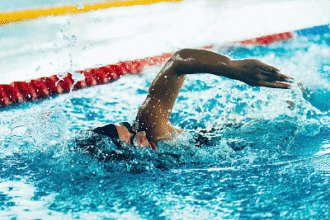Understanding Running
Running is a fundamental form of human locomotion performed on land with alternating support phases in which, at true running speeds, there is a brief moment when neither foot contacts the ground. As exercise, it spans an aerobic–anaerobic continuum: easy, sustained efforts primarily tax aerobic metabolism, whereas short, fast bouts draw increasingly on anaerobic pathways. Its simplicity, low equipment needs, and adaptability to different ages and fitness levels make running a practical daily habit and an effective cornerstone of aerobic training.
Good running begins with relaxed, repeatable technique rather than rigid choreography. Aim for an upright posture with a slight forward inclination from the ankles, a neutral gaze, and relaxed shoulders. Let the arms swing comfortably near the waist with elbows roughly bent, hands unclenched, and a natural forward–back motion coordinated with the legs. Strive to land the foot close to beneath your center of mass to reduce braking forces; whether the initial contact is on the rearfoot, midfoot, or forefoot can vary by speed, surface, and individual anatomy. Cadence commonly increases as pace quickens and, for many runners, falls in a moderately brisk range, but there is no single ideal number—economy and comfort are better guides than chasing a preset step rate.
Starting and stopping smoothly protects the heart, lungs, and musculoskeletal system. Before the main work, spend several minutes walking or jogging easily to raise temperature and prepare joints and tissues. At the end, down‑shift to a gentle jog or walk to allow heart rate and ventilation to come down gradually, aiding venous return and comfort. Avoid abruptly squatting or lying down immediately after stopping; staying upright while you cool down helps circulation normalize. Rehydrate after exercise according to thirst with small, regular sips to replace fluid without provoking gastrointestinal discomfort, and add a light snack if the session was long or intense.
Breathing should remain steady and matched to effort. Many runners find a comfortable rhythm when inhaling through the nose and mouth together during easier running and switching to whatever pattern feels natural as intensity rises. Coordinating exhalation with footfalls can help maintain a relaxed torso and reduce unnecessary tension around the ribs and shoulders. Over time, practice fosters an easy, economical pattern of breathing that supports endurance without strain.
Progress comes from consistency and gradualism. Rather than focusing on commands or exaggerated arm positions, prioritize an even effort you can repeat across days. Newer or returning runners can alternate short segments of easy jogging with walking until continuous running feels comfortable, then extend duration slowly. Those preparing for formal training or competition can introduce controlled upticks in pace on occasion, always returning to smooth mechanics and avoiding hurried increases in volume or intensity that outpace the body’s ability to adapt.
The health effects of a regular running habit are broad. Cardiovascular benefits include a stronger myocardium, improved stroke volume and cardiac output, and more responsive blood vessels, all of which support better oxygen delivery during daily life and exercise. Repeated muscular contractions in the legs, trunk, and arms build strength and endurance in postural and propulsive muscles, and this whole‑body engagement can raise basal metabolic rate modestly over time. When combined with appropriate nutrition, running helps shift body composition by reducing excess fat stores while preserving or improving lean tissue, supporting a leaner, more functional physique.
Running also influences how the body carries itself. Practicing relaxed arm swing around the rib cage and stable trunk rotation can contribute to better posture and a more balanced silhouette. As coordination improves, movement often looks and feels smoother, which many runners experience as a subtle enhancement of their overall figure and carriage. While no exercise can sculpt specific curves on command, routine running paired with mobility and strength work promotes symmetry and confidence in movement.
Mental and emotional benefits are equally compelling. Outdoor running exposes you to fresh air and natural light, which can stabilize circadian rhythms and elevate mood. The rhythmic, repetitive nature of running helps discharge accumulated stress from study or work and can prompt a state of relaxed focus that many find restorative. Neurochemical shifts during and after running—including endorphins, endocannabinoids, and other modulators of stress—often leave people feeling calmer and more energized, with improved concentration and a brighter outlook.
Practical safety enhances the likelihood that running becomes a sustainable practice. Choose stable surfaces and footwear that feel comfortable for your stride and the distances you plan to cover. Increase weekly mileage and intensity gradually, watching for warning signs such as chest discomfort, unusual breathlessness, dizziness, or joint pain that alters your gait; if these occur, stop and seek professional guidance. Warm‑ups and cool‑downs should bookend most sessions, and easy days, adequate sleep, and supportive nutrition convert training stress into durable adaptation. Technique cues should remain gentle reminders, not rigid rules; your goal is a relaxed, repeatable style that fits your body today.
In essence, running is both simple and nuanced: simple in its accessibility and minimal requirements, nuanced in the way small adjustments to posture, rhythm, and progression shape comfort and results. By focusing on smooth mechanics, gradual improvement, and basic recovery practices, you can reap the full spectrum of benefits—cardiovascular fitness, body composition changes, postural confidence, stress relief, and general vitality—while keeping the practice enjoyable and safe across the long term.







